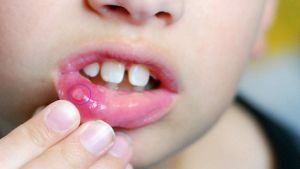 Suddenly, sores in the mouth in a child can be a sign of various changes in the body and become a consequence of any adverse event.
Suddenly, sores in the mouth in a child can be a sign of various changes in the body and become a consequence of any adverse event.
To conduct proper therapy, it is necessary to first understand the nature of the origin of the neoplasm. In what, certainly, the expert will help.
Children are more prone to appearing, ulcers, pimples, aphthus and wounds, they are very sensitive to various bacteria and are more often exposed to traumatic effects from the outside.
Content
- complex provoking reasons
- Diseases
- mucous mucosa injury
- Systemic diseases
- Related symptoms
- disease diagnosis
- Treatment of affected areas
- Complex therapy
- traditional medicine
- Possible complications
- Preventive measures
complex provoking reasons
reasons, provoking the manifestation of ulcers andacne in a baby on the oral mucosa are divided into three groups:
- local diseases;
- skin injury;
- common diseases.
Diseases of the mucous
Most often, the appearance of white sores and pimples in the mouth in a child provokes such dental diseases:
- Aphthous stomatitis - often this illness has a chronic form. Its peculiarity is the periodic occurrence of abscesses or
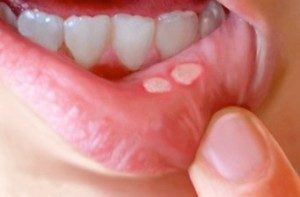 aft, which interfere with eating and talking normally. Heals formations from a week to a month, depending on the presence of complicating moments. After them, scars often remain.
aft, which interfere with eating and talking normally. Heals formations from a week to a month, depending on the presence of complicating moments. After them, scars often remain. - Herpetic stomatitis is an accumulation of small ulcers that are similar to herpes without clear boundaries. Heals within a week, without leaving a trace.
- Stomatitis - most often one or more wounds occur. In the center of such an ulcer is covered with white or gray film.
- Candidiasis stomatitis - most often occurs in infants, the entire area of the mucous membrane is affected by a white coating.
- Recurrent necrotic periadenitis is a very painful condition that can last for months. Formed aphthae with raised edges, in the center have accumulation of lymph and blood.
- Bednar Afts is a malaise that is peculiar only to children, because of poor oral hygiene ulcers with yellow coating appear.
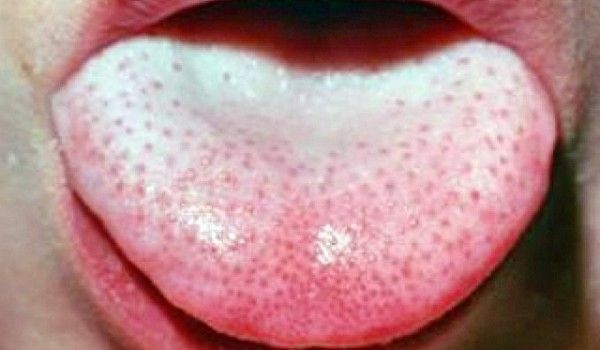
In the photo, the characteristic signs of a child's stomatitis are sores in the language
Mucosal Injuries
These triggers are attributed to the following factors:
- teeth sting in the future can provoke the development of sores;
- injury due to a very tough toothbrush;
- exposure to corrosive chemicals;
- sharp edges of teeth or poor-quality fillings;
- poorly matched bracket systems for correcting malocclusion;
- injury to mucous instruments during dental treatment.
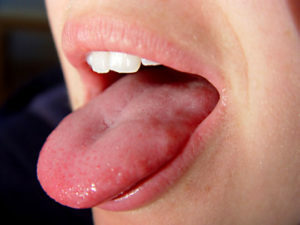 Such ulcers are often single, the wounds heal in speed after the elimination of the traumatic element. These formations do not give very painful sensations, unless they are irritated by acute or hot food.
Such ulcers are often single, the wounds heal in speed after the elimination of the traumatic element. These formations do not give very painful sensations, unless they are irritated by acute or hot food.
In some cases, wounds, as a result of injuries, can become provocateurs for the occurrence of chronic ulcerative diseases with a wide range of lesions, for example, aphthous stomatitis.
Systemic diseases
Diseases - provokers of development of oral wounds:
- Necrotizing gingivostomatitis - appears against a background of low immunity, viral infections, stomatitis due to allergies. Formations with uneven edges, greenish coating and blood secretions affect all parts of the cavity without exception. This form is accompanied by an unpleasant odor, strong saliva and an increase in temperature.
- Tuberculosis of the lungs also extends to the oral mucosa, because of the active vital activity of the tuberculosis bacterium. The development of
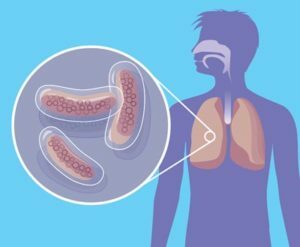 begins with a small tuberculous elevation. An ulcer with blood, loose structure, small in volume and having uneven edges, with their development there are signs of fever.
begins with a small tuberculous elevation. An ulcer with blood, loose structure, small in volume and having uneven edges, with their development there are signs of fever. - Syphilis is the causative agent of pale treponema, an infectious disease. In all periods of the disease, furuncles are present.
- HIV - in most cases, the gum is damaged.
Also the cause of the appearance of aft can become:
- chronic problems with the digestive tract - atonic colitis, hepatocholecystitis, dysbiosis;
- cardiovascular disease - decompensated form of heart failure;
- hematopoietic disorders - leukemia, anemia, hemophilia;
- problems of the endocrine system - diabetes, hypothyroidism.
Concomitant symptomatology
If a child has oral wounds not due to trauma, then there are concomitant symptoms of the disease of the shell:
- a sharp rise in temperature to 39 degrees;
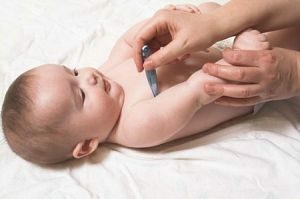
- capriciousness, due to burning and dryness in the cavity;
- refusal of food, as it causes painful sensations;
enlarged lymph nodes; - appearance of the plaque from white to greenish color;
- often causes nausea, headaches, chills;
- formations bleed, may contain lymph with purulent discharge, which provokes an unpleasant odor;
- pain in the throat and during swallowing;
- traces of swelling on the neck and gums.
If injuries occur as a result of injuries at the injury site:
- there are hematomas, abrasions, erosions, abscesses have a different size;
- if the wound becomes infected, a prolonged healing process occurs;
- occurs infiltration of the mucous layer, limited redness;
Diagnosis of the disease
If damage to the mucosa is isolated, it is easy to identify, as everything can be seen from an anamnesis. However, in the case of combined effects, additional diagnostic measures are required.
To diagnose the occurrence of chronic mucosal damage in children, it is necessary:
- to conduct a thorough collection of the medical history;
- carefully examine the objective evidence of disease;
- , there is a need for differential diagnosis of to determine the presence of similarity with similar subjective and objective symptoms of long-healing wounds of a specific nature - tuberculosis, AIDS, syphilis, trophic disorders in the decompensated position of organs within the body;
- for more accurate determination of perform a cytological and bacteriological study of the contents of ulcers .
In case of oral diseases, only the dentist will make an accurate diagnosis and prescribe adequate treatment, otherwise you can aggravate the child's condition with infections and complications.
Treatment of affected areas
The goal of any treatment is to facilitate the patient's condition and complete recovery from the ailment and its symptoms.
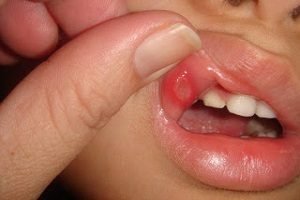 If the child's sores in the mouth are caused by mechanical damage, the treatment consists in removing the foreign object and processing the place of the injury.
If the child's sores in the mouth are caused by mechanical damage, the treatment consists in removing the foreign object and processing the place of the injury.
In case of a chemical burn, rinse with soapy water, a solution of soda or citric acid. In the event of ingestion of arsenic, the mouth is treated with 1% solution of Iodinol or 5% Unithiol.
Complex therapy
But more often the sores and pimples in the mouth appear as a result of local or systemic disease. In this case, complex therapy is used:
- antiviral and analgesic agents of local action, for example, ointment Zovirax, Arbidol, Vinilin and others;

- rinsing with herbal solution or antiseptic;
- antipyretic drugs;
- plentiful drink;
- in the chronic form of stomatitis requires a complex effect on the body;
- in the case of bacterial types of disorders requires the use of antibiotics and antiallergenic drugs;
- in any case requires the reception of vitamin complexes and hygiene.
If the occurrence of ulcers is triggered by the presence of common diseases, therapy aimed at suppression of ulcerative formations should be carried out in conjunction with the treatment of the underlying disease as a provoking element.
Traditional medicine
Also the treatment of sores in the mouth in a child can be carried out with the help of traditional medicine.
Among the many recipes tried by traditional healers, the following is allocated:
- mixture of 1/2 cup of milk with yolk, plus a dessert spoon of honey, this liquid is wiped daily by the whole oral cavity, recovery occurs on day 3;
- is also processed with a mixture of ground almonds and honey;
- a marigold broth cooked in a water bath is an excellent mouthwash;

- for rinsing is applied and the decoction of the tinder, elecampane, saline, thyme grass;
- chicken protein, diluted in 100 ml of water, is used to rinse every 2 hours;
- for 3 weeks is taken yarrow juice with honey for 3 tablespoons daily;
- if the jaundice is very hard for the baby to rinse, you can apply a mixture of chamomile, marigold and linden flowers;
- is well helped by the treatment with peroxide and the use of horseradish with carrot juice.
Possible complications of
Without the necessary and timely therapy, the following complications will follow:
- because of a refusal to eat, the weight of the baby will decrease, as a consequence of the delay in growth and physical development;
- frequent ulcerous phenomena will begin to destroy enamel and cause dental diseases;
- the presence of wounds will lead to a decrease in immunity, the baby will become predisposed to viral and infectious diseases.
Preventive measures
In order to avoid the appearance of a violation it is necessary to remember the following rules:
- remind the baby that the food should be thoroughly chewed;
- wash hands after the street and before eating;

- is serious about choosing a dental clinic;
- pick up toothpaste without lauryl sulfate;
- remember that sores can appear due to nervous shocks or during hormonal changes in the body;
- formation of wounds provokes a lack of vitamins;
- presence of hereditary predisposition - an occasion for observation at the doctor;
- must be carefully monitored so that the baby does not take sharp objects.
It is necessary to carefully monitor the child, monitor his games and movements, do not allow the baby to lick and try, everything that is around, especially outside the house.
If the formation of aft has already occurred, the child should immediately be shown to a specialist, even if they do not bother him. After all, this education can be a sign not only of a local disease, but also a sign of a formidable pathology.
And, of course, it is necessary to provide children with the necessary amount of vitamins and a varied diet.
